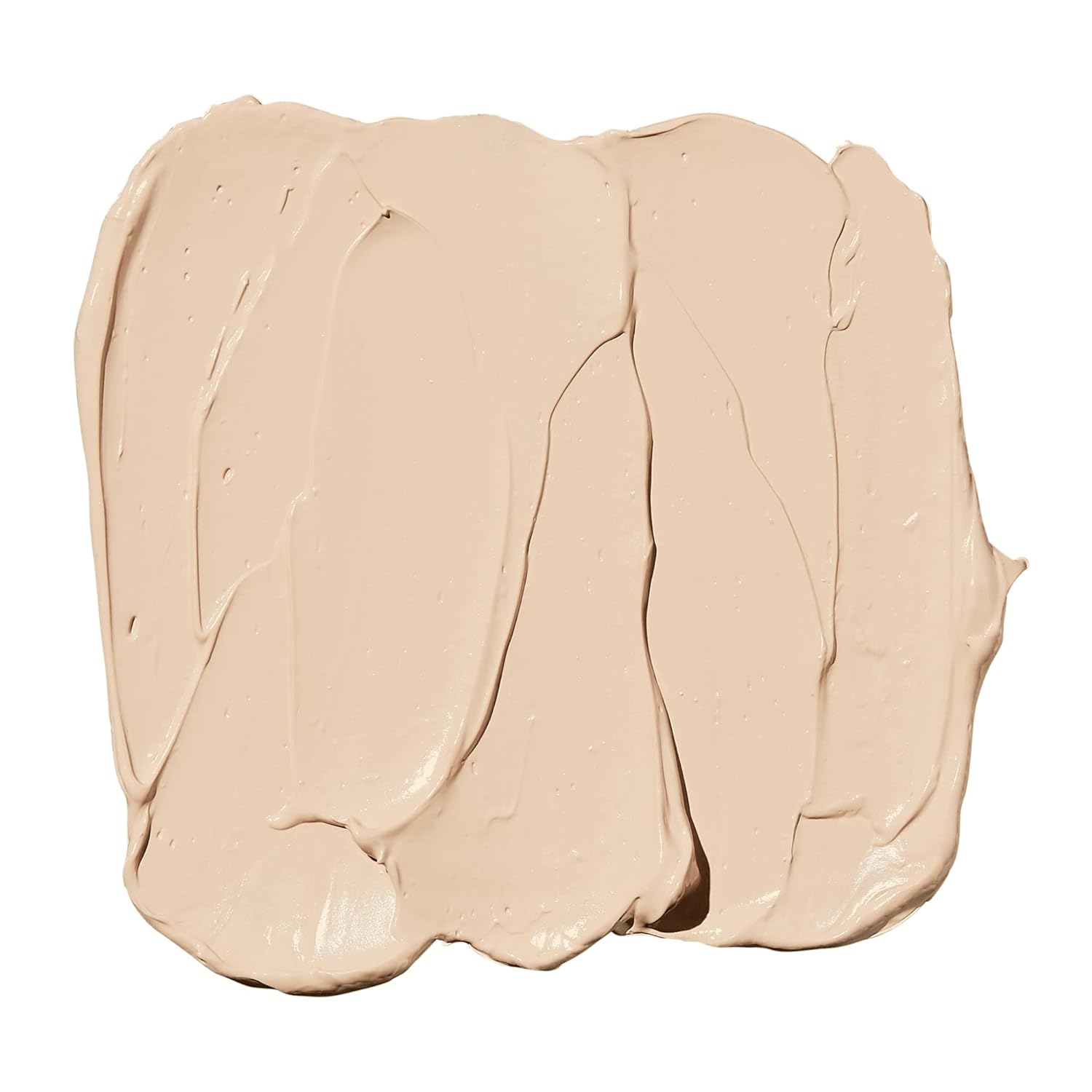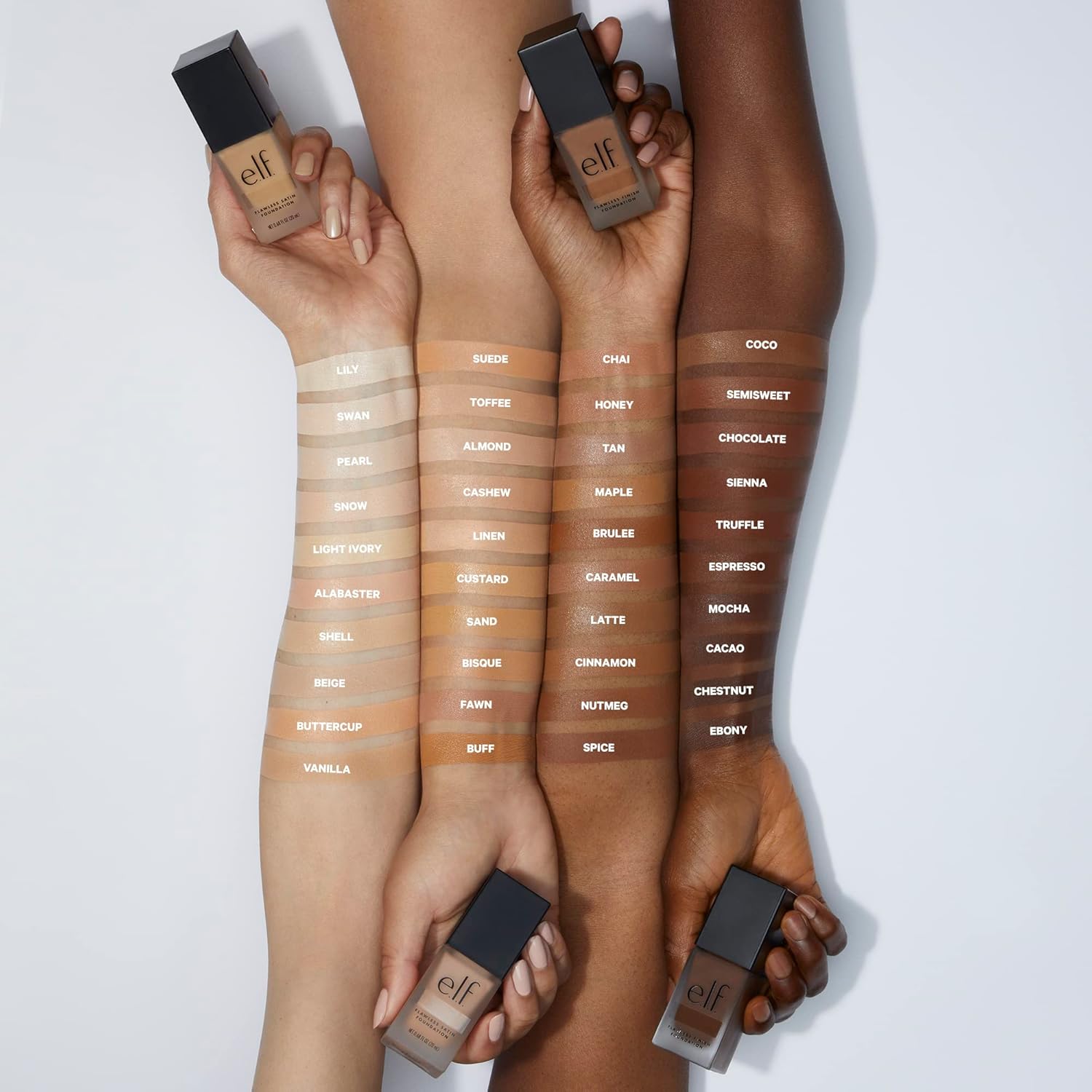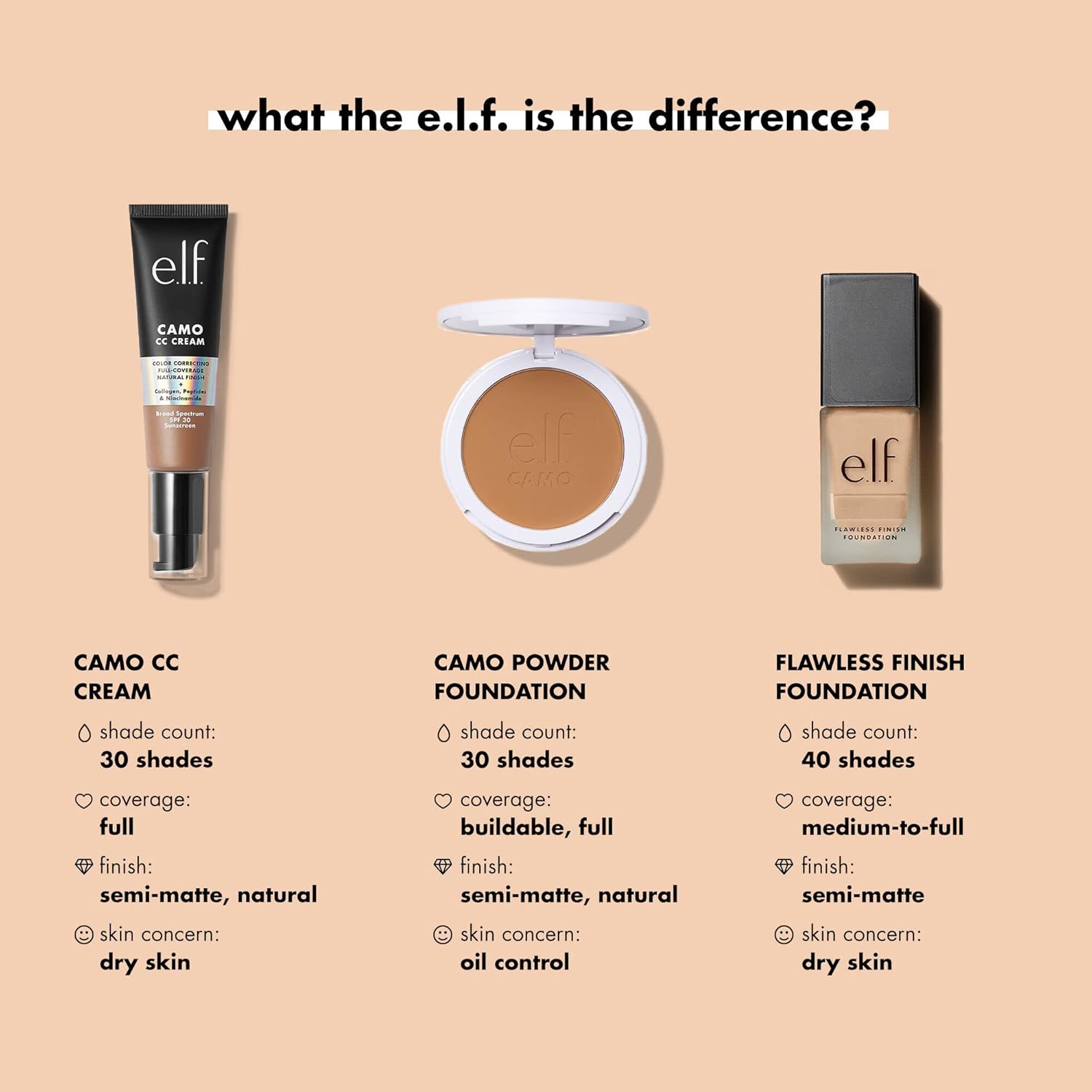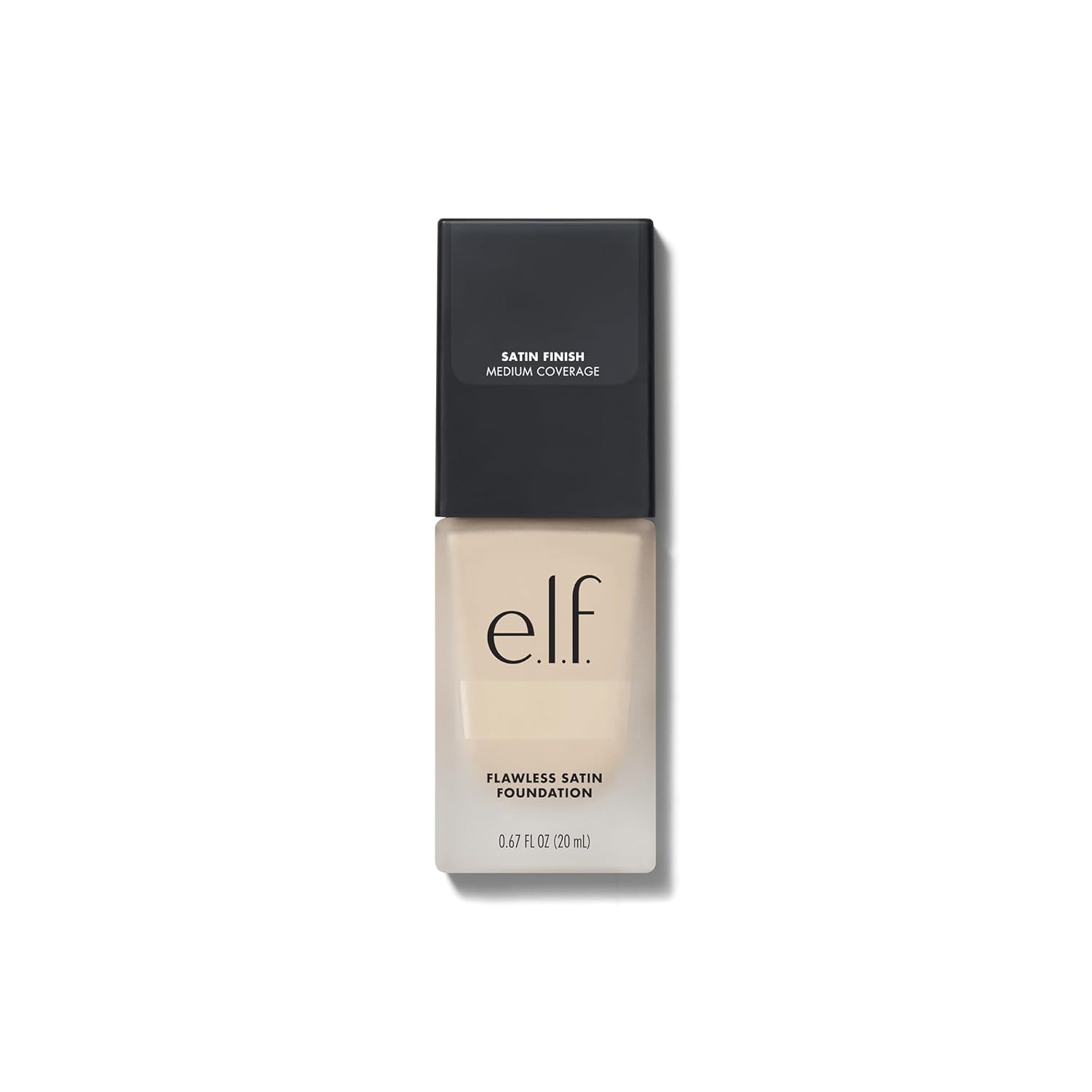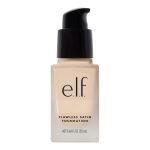
e.l.f. Flawless Satin Foundation, Review foundation Buying Guide – Oemiu
e.l.f. Flawless Satin Foundation: A Deep Dive and Foundation Buying Guide
Finding the perfect foundation can feel like a never-ending quest. With countless brands, formulations, and finishes available, it’s easy to get lost in the beauty aisle. Today, we’re focusing on a budget-friendly contender that has garnered significant attention: the e.l.f. Flawless Satin Foundation. This article provides a comprehensive review of the e.l.f. Flawless Satin Foundation, alongside a detailed buying guide to help you navigate the complex world of foundations and discover the best long-lasting foundation for your needs.
Unveiling e.l.f. Flawless Satin Foundation: An In-Depth Review
e.l.f. (Eyes Lips Face) has built a reputation for offering high-quality cosmetics at accessible prices. The Flawless Satin Foundation aims to deliver on this promise by providing a medium-coverage, satin-finish base that caters to a variety of skin types. But does it live up to the hype? Let’s delve into its key aspects.
One of the first things you’ll notice is the surprisingly wide shade range. e.l.f. has expanded its offerings over the years to become more inclusive, recognizing the diverse spectrum of skin tones. While the exact number of shades may vary depending on the retailer, the Flawless Satin Foundation generally boasts a decent selection, making it more likely for individuals to find a suitable match. The packaging is simple yet functional – a glass bottle with a pump dispenser. While not the most luxurious, it’s practical and allows for controlled product dispensing, minimizing wastage.
The foundation itself has a lightweight, slightly liquid consistency. It’s easy to blend, whether you use a makeup sponge, brush, or your fingers. Upon application, it provides a noticeable blurring effect, minimizing the appearance of pores and fine lines. The satin finish strikes a balance between dewy and matte, offering a natural-looking radiance without excessive shine. This makes it suitable for normal, combination, and even slightly oily skin types. For those with very oily skin, a mattifying primer and setting powder may be necessary to control shine throughout the day. Users seeking a natural look will find this foundation to be a go to choice.
The coverage is buildable, allowing you to achieve your desired level of concealment. One layer provides a light to medium coverage, effectively evening out skin tone and minimizing minor imperfections. You can build it up to medium coverage to cover blemishes and discoloration without feeling heavy or cakey. However, it’s important to note that this foundation is not designed for full coverage. Those with severe acne or significant scarring may require additional concealer to achieve their desired result. A key advantage for those with sensitive skin is that this oil free foundation is formulated without harsh chemicals, like parabens and sulfates.
The longevity of the e.l.f. Flawless Satin Foundation is decent, lasting for around 6-8 hours with minimal fading or creasing. This can be extended with the use of a primer and setting spray. While it may require a touch-up throughout the day, particularly in the T-zone for those with oily skin, it holds up reasonably well compared to other foundations in its price range. It’s also worth noting that the foundation doesn’t oxidize significantly, meaning the color stays true to what you initially applied.
Here’s a summary of the pros and cons:
- Pros:
- Affordable price point
- Good shade range
- Lightweight and blendable formula
- Satin finish provides a natural-looking radiance
- Buildable coverage
- Doesn’t oxidize significantly
- Pump dispenser
- Cons:
- May not be suitable for very oily skin without additional products
- Not full coverage
- Packaging is basic
Foundation Finish Breakdown: Finding Your Perfect Match
Choosing the right foundation finish is crucial for achieving a flawless look. The finish refers to the level of shine or matte-ness that the foundation imparts on your skin. Different finishes are better suited for different skin types and preferences. Understanding the nuances of each finish will help you select a foundation that complements your skin’s natural characteristics.
Matte Foundation: Matte foundations are ideal for oily skin types as they absorb excess oil and minimize shine. They typically provide a full coverage and have a velvety, non-reflective finish. However, matte foundations can sometimes look flat or cakey, especially on dry skin. It’s important to properly moisturize and prime your skin before applying a matte foundation to prevent it from clinging to dry patches.
Satin Foundation: As the name suggests, satin foundations offer a smooth, slightly luminous finish that mimics the look of healthy skin. They strike a balance between matte and dewy, making them suitable for normal, combination, and even slightly oily skin types. Satin foundations generally provide medium coverage and have a natural-looking radiance. The e.l.f. Flawless Satin Foundation falls into this category, offering a comfortable and versatile option for everyday wear.
Dewy Foundation: Dewy foundations are designed to impart a radiant, glowing finish to the skin. They are best suited for dry or mature skin types as they add moisture and luminosity. Dewy foundations typically provide light to medium coverage and have a sheer, hydrating formula. However, they can sometimes make oily skin look overly shiny. If you have oily skin and want to try a dewy foundation, consider using a mattifying primer and setting powder in areas that tend to get oily.
Semi-Matte Foundation: A semi-matte foundation offers a finish that is neither overly dewy nor completely matte. This is a good option for those with combination skin or those who want a natural-looking finish that lasts. They offer a balance, which often makes them a versatile choice for many individuals looking for a long-lasting foundation.
Radiant Foundation: Similar to dewy foundations, radiant foundations provide a luminous and healthy-looking glow. However, radiant foundations often contain light-reflecting particles that enhance the skin’s natural radiance. They are best suited for dull or tired-looking skin as they add brightness and vitality. Radiant foundations typically provide light to medium coverage and have a hydrating formula.
When choosing a foundation finish, consider your skin type, desired coverage level, and personal preferences. Experiment with different finishes to find the one that works best for you. Remember that you can always customize your foundation finish by using a primer, setting powder, or finishing spray.
Deciphering Foundation Formulas: Liquids, Creams, Powders, and More
Beyond the finish, the formula of a foundation plays a significant role in its performance and suitability for different skin types. Foundations come in various forms, each with its unique characteristics and benefits. Understanding the different types of foundation formulas will help you choose one that meets your specific needs and preferences.
Liquid Foundation: Liquid foundations are the most popular type of foundation and offer a wide range of finishes, coverage levels, and formulas. They are versatile and can be applied with a makeup sponge, brush, or your fingers. Liquid foundations are available in both water-based and oil-based formulas, catering to different skin types. Water-based foundations are generally better suited for oily skin, while oil-based foundations are more hydrating and ideal for dry skin. The e.l.f. Flawless Satin Foundation is a liquid foundation known for its blendability and natural-looking finish.
Cream Foundation: Cream foundations are thicker and more emollient than liquid foundations. They provide medium to full coverage and are ideal for dry or mature skin as they add moisture and plumpness. Cream foundations can be applied with a makeup sponge or brush. However, they may not be suitable for oily skin as they can feel heavy and greasy. Cream foundations are often packaged in pots or compacts.
Powder Foundation: Powder foundations are lightweight and easy to apply. They provide light to medium coverage and are ideal for oily skin as they absorb excess oil and minimize shine. Powder foundations can be applied with a powder brush or sponge. They are available in both loose and pressed formulas. Powder foundations are a good option for quick touch-ups throughout the day. Some powder foundations can be found in mineral make up as well.
Stick Foundation: Stick foundations are convenient and portable, making them ideal for travel. They provide medium to full coverage and can be applied directly to the skin or with a makeup sponge or brush. Stick foundations are available in various formulas, catering to different skin types. However, they can sometimes feel heavy or cakey if not applied properly.
Tinted Moisturizer: Tinted moisturizers are lightweight and provide sheer coverage. They are ideal for those who want a natural-looking complexion with minimal makeup. Tinted moisturizers hydrate the skin while providing a hint of color. They are a good option for dry or sensitive skin.
BB Cream (Beauty Balm): BB creams are multi-tasking products that combine the benefits of a moisturizer, sunscreen, and foundation. They provide light to medium coverage and are ideal for those who want a quick and easy makeup routine. BB creams are available in various formulas, catering to different skin types.
When choosing a foundation formula, consider your skin type, desired coverage level, and lifestyle. Experiment with different formulas to find the one that works best for you. Read reviews and compare ingredients to make an informed decision.
| Foundation Type | Coverage | Skin Type | Benefits | Drawbacks |
|---|---|---|---|---|
| Liquid | Light to Full | All Skin Types (depending on formula) | Versatile, Wide Range of Finishes | Can be messy, Requires application tools |
| Cream | Medium to Full | Dry, Mature | Hydrating, Plumping | Can feel heavy, Not suitable for oily skin |
| Powder | Light to Medium | Oily | Absorbs oil, Easy to apply | Can look dry, May accentuate fine lines |
| Stick | Medium to Full | All Skin Types (depending on formula) | Portable, Convenient | Can be heavy, May require blending |
| Tinted Moisturizer | Sheer | Dry, Sensitive | Hydrating, Natural-looking | Minimal coverage |
| BB Cream | Light to Medium | All Skin Types | Multi-tasking, Convenient | Limited shade range |
The Art of Shade Matching: Finding Your Perfect Undertone
Finding the right foundation shade is essential for achieving a seamless and natural-looking complexion. A foundation that is too light or too dark will be noticeable and can make your skin look ashy or muddy. The key to shade matching lies in understanding your undertone. Undertones are the subtle hues that lie beneath the surface of your skin and influence how colors appear on your complexion. Identifying your undertone will help you choose a foundation that complements your skin’s natural coloring.
There are three main undertones: warm, cool, and neutral. Warm undertones have yellow, golden, or peachy hues. Cool undertones have pink, red, or blue hues. Neutral undertones have a balance of warm and cool hues. Here are some tips for identifying your undertone:
- The Vein Test: Look at the veins on your wrist in natural light. If your veins appear blue or purple, you likely have cool undertones. If your veins appear green, you likely have warm undertones. If you can’t tell whether your veins are blue or green, you likely have neutral undertones.
- The Jewelry Test: Which metal looks better against your skin: gold or silver? If gold looks better, you likely have warm undertones. If silver looks better, you likely have cool undertones. If both gold and silver look good, you likely have neutral undertones.
- The Clothing Test: Which colors make your skin look brighter and more radiant: warm colors (red, orange, yellow) or cool colors (blue, green, purple)? If warm colors look better, you likely have warm undertones. If cool colors look better, you likely have cool undertones. If both warm and cool colors look good, you likely have neutral undertones.
Once you have determined your undertone, you can start looking for a foundation shade that matches your skin tone and undertone. When testing foundations, apply a small amount to your jawline and blend it in. Check the color in natural light to see if it matches your skin. The foundation should disappear seamlessly into your skin without leaving a visible line.
It’s also important to consider the season when choosing a foundation shade. Your skin tone may be lighter in the winter and darker in the summer. You may need to adjust your foundation shade accordingly to maintain a natural-looking complexion. Some brands offer a wide variety of shades, making the journey to find the best hydrating foundation easier. Always test the foundation on your skin before purchasing it, as the color may look different in the bottle than it does on your face.
Application Techniques: Mastering the Flawless Foundation Look
Even the best foundation can look subpar if not applied correctly. Mastering proper application techniques is crucial for achieving a flawless and natural-looking complexion. The right tools and techniques can enhance the performance of your foundation and ensure that it blends seamlessly into your skin. The most common tools for foundation application include makeup sponges, brushes, and your fingers. Each tool offers a different level of coverage and finish.
Makeup Sponges: Makeup sponges, such as the Beautyblender, are ideal for achieving a natural, airbrushed finish. They provide sheer to medium coverage and are best used with liquid or cream foundations. To use a makeup sponge, dampen it with water and squeeze out the excess. Then, bounce the sponge across your skin to apply the foundation. The damp sponge will help to sheer out the foundation and prevent it from looking cakey.
Brushes: Foundation brushes offer a variety of coverage levels and finishes. Flat foundation brushes provide full coverage and are best used for creating a flawless base. Buffing brushes provide medium coverage and are ideal for blending foundation seamlessly into the skin. Stippling brushes provide light to medium coverage and are best used for creating a natural, airbrushed finish.
Fingers: Applying foundation with your fingers can provide light to medium coverage and a natural-looking finish. The warmth of your fingers helps to melt the foundation into your skin, creating a seamless blend. To apply foundation with your fingers, dot the foundation onto your face and then blend it in using gentle, circular motions. This is a quick and efficient method for everyday wear.
Before applying foundation, it’s important to prep your skin properly. Start by cleansing and moisturizing your skin. Then, apply a primer to create a smooth and even base for your foundation. A primer will also help to extend the wear time of your foundation and prevent it from settling into fine lines and pores.
When applying foundation, start with a small amount and build up the coverage as needed. Avoid applying too much foundation at once, as this can make your skin look cakey. Focus on areas that need the most coverage, such as blemishes, redness, or discoloration. Blend the foundation seamlessly into your skin, paying attention to your hairline, jawline, and ears. Set your foundation with a translucent powder to prevent it from creasing or fading throughout the day.
Frequently Asked Questions (FAQ)
What skin type is e.l.f. Flawless Satin Foundation best suited for?
e.l.f. Flawless Satin Foundation is generally well-suited for normal, combination, and slightly oily skin types. Its satin finish provides a natural-looking radiance without excessive shine, making it a comfortable option for those who don’t want a completely matte or overly dewy look. For those with oily skin, a mattifying primer and setting powder may be necessary to control shine throughout the day. People with dry skin may find it slightly less hydrating than they prefer, so a hydrating primer and moisturizer underneath would be beneficial. While it’s often marketed as a universal option, considering your specific skin needs is always the best approach. The foundation’s lightweight formula and buildable coverage also make it a good option for those who don’t want a heavy or cakey feeling on their skin. Ultimately, it depends on your skin’s individual needs and preferences, but it is a popular choice for its versatile nature.
How does e.l.f. Flawless Satin Foundation compare to other drugstore foundations?
e.l.f. Flawless Satin Foundation stands out in the drugstore market for its affordability and decent quality. Compared to other budget-friendly foundations, it often outperforms in terms of shade range and finish. Many drugstore foundations offer limited shade options, but e.l.f. has made efforts to become more inclusive. In terms of finish, the satin finish of this foundation is a good middle ground between matte and dewy, which is not always easy to find in the drugstore. Some drugstore foundations can be too matte and drying, while others can be too oily and shiny. The e.l.f. Flawless Satin Foundation strikes a balance, making it a versatile option for many skin types. However, some higher-end drugstore foundations may offer better longevity or more specialized formulas for specific skin concerns.
Is e.l.f. Flawless Satin Foundation cruelty-free and vegan?
Yes, e.l.f. is a proudly cruelty-free and vegan brand. This means that they do not test their products on animals, and their products do not contain any animal-derived ingredients. This commitment to ethical practices is a major selling point for many consumers who are looking for beauty products that align with their values. e.l.f. is certified by PETA (People for the Ethical Treatment of Animals) as a cruelty-free and vegan brand. This certification provides assurance that their products meet strict criteria for ethical sourcing and production. Knowing that you are using a cruelty-free and vegan foundation can give you peace of mind and make you feel good about your purchase.
How can I make e.l.f. Flawless Satin Foundation last longer?
To extend the wear time of e.l.f. Flawless Satin Foundation, proper skin preparation and application techniques are key. Start with a clean and moisturized face. Then, apply a primer that is suitable for your skin type. A mattifying primer can help to control shine for oily skin, while a hydrating primer can add moisture for dry skin. Apply the foundation in thin layers, building up the coverage as needed. Avoid applying too much foundation at once, as this can make it look cakey and prone to creasing. Set your foundation with a translucent powder, focusing on areas that tend to get oily, such as the T-zone. A setting spray can also help to lock in your makeup and prevent it from fading throughout the day. Consider carrying blotting papers for touch-ups if your skin tends to get oily.
What are some good primers to use with e.l.f. Flawless Satin Foundation?
The best primer to use with e.l.f. Flawless Satin Foundation depends on your skin type and desired finish. For oily skin, a mattifying primer like the e.l.f. Matte Putty Primer or the NYX Shine Killer Primer can help to control shine and create a smooth base for your foundation. For dry skin, a hydrating primer like the e.l.f. Hydrating Face Primer or the L’Oréal Hydra Perfecte Smoothing Primer can add moisture and prevent the foundation from clinging to dry patches. For normal or combination skin, a blurring primer like the e.l.f. Poreless Putty Primer or the Maybelline Master Prime Blur + Smooth Primer can minimize the appearance of pores and create a smooth canvas for your foundation. Experimenting with different primers can help you find the one that works best for your skin.
Does e.l.f. Flawless Satin Foundation oxidize?
Oxidation refers to the process where a foundation changes color after it has been applied to the skin, often turning more orange or darker. e.l.f. Flawless Satin Foundation is generally known for not oxidizing significantly. However, individual experiences can vary depending on skin chemistry and environmental factors. To minimize the risk of oxidation, it’s always a good idea to test the foundation on your skin for a few hours before committing to a full-face application. Additionally, using a primer can create a barrier between your skin and the foundation, which can help to prevent oxidation. If you notice that your foundation is oxidizing, you may need to choose a shade that is slightly lighter than your natural skin tone.
Is e.l.f. Flawless Satin Foundation suitable for mature skin?
e.l.f. Flawless Satin Foundation can be a good option for mature skin, but certain considerations should be kept in mind. Mature skin often benefits from foundations that provide hydration and don’t settle into fine lines and wrinkles. While this foundation has a satin finish that offers some luminosity, ensuring adequate hydration underneath is crucial. Using a hydrating primer and a rich moisturizer before applying the foundation can help to prevent it from looking dry or emphasizing texture. It’s also essential to apply the foundation sparingly and blend it well to avoid a cakey appearance. Setting it with a light dusting of powder in areas prone to creasing can help to prolong its wear. Ultimately, its lightweight feel and buildable coverage, combined with the right skincare preparation, can make it a suitable choice for mature skin seeking a natural-looking finish.

